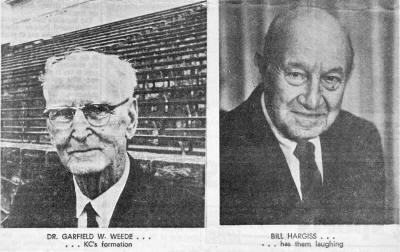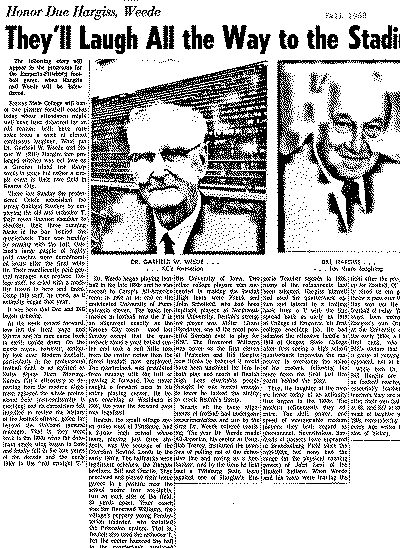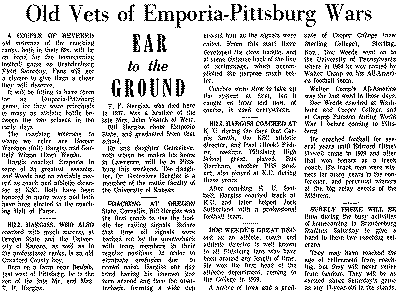|
|
 They'll
Laugh All the Way to the Stadium
They'll
Laugh All the Way to the Stadium
Fall 1968
Honor due Bill Hargiss, Doc Weede,
The following story will appear in the programs
for the Emporia-Pittsburg football game, when Hargiss and Weede will be introduced.
Kansas State College will honor two pioneer football coaches
today whose attendance might well have been debarred for an odd reason; both have
sore sides from a week of almost continuous laughter. What put Dr. Garfield W. Weede
and Homer W. (Bill) Hargiss into prolonged stitches was not love on a Grecian island
nor sharp words in space but rather a simple event in their own field in Kansas
City.
There last Sunday the professional Chiefs astonished the
strong Oakland Raiders by employing the old and orthodox T, their seven linemen
shoulder to shoulder, their three running backs in the bar behind the quarterback.
They won handily by running with the ball. Oakland's large gaggle of highly paid coaches were dumbfounded hours after the final whistle.
Their munificently paid general manager was profane. College stuff, he cried with
a modifier tossed in here and there. Using 1940 stuff, he cried, as if antiquity
began that year.
large gaggle of highly paid coaches were dumbfounded hours after the final whistle.
Their munificently paid general manager was profane. College stuff, he cried with
a modifier tossed in here and there. Using 1940 stuff, he cried, as if antiquity
began that year.
It was here that Doc and Bill began grinning.
As the week moved forward, love left the front page and
Schirra and his men came back to earth upside down. On the sports pages, however,
antiquity took over. Modern football, particularly in the professional football
field, is as stylized as Swiss Alpine Horn Blowing. Kansas City's effrontery in
departing from the modern alignment agitated the whole professional field (non-conformity
is catching) and its chroniclers felt impelled to review the history of the football
offense, going far beyond the Oakland general manager. That is, they went back to
the 1930s when the dominant single wing began to fade and finally fell in the late
years of the decade and the early 1940s to the "old straight T."
Dr. Weede began playing football in the late 1890s and
he was named to Camp's All-America team in 1904 as an end on the undefeated University
of Pennsylvania eleven. The basic formation in football was the T in an alignment
exactly as the Kansas City team used last Sunday except that the quarterback stood
a yard behind center and took a soft little toss from the center rather than the
direct handoff now employed. The quarterback was prohibited from running with the
ball or passing it forward. Doc never caught a forward pass in his entire playing
career. He began coaching at Washburn in 1906, the year the forward pass was legalized.
Beulah, the small village seven miles west of Pittsburg,
had a 2-year high school whose team, playing just three students, was the scourge
of the Cherokee Neutral Lands in the early 1900's. The halfbacks were legitimate
scholars, the Hargiss brothers, Bill and Charlie. They practiced and played their
home games in a pasture near the school under four arc-lights, two on each side
of the field, 30 yards apart. Their coach was the Reverend Williams, the village's
peppery young Presbyterian minister, who installed the Princeton system. That is,
Beulah also used the orthodox T, but the center bounced the ball to the quarterback,
stationed one yard back. He was Bert Potter, who had been a star at the University
of Iowa. Two other college players who succeeded in making the Beulah High team
were Frank and John Schofield, who had been topflight players at Northwestern University.
Beulah's strongest player was Miller (Jum) Hyndman, one of the most powerful linemen
ever to play for KSC. The Reverend Williams was never on the first eleven at Princeton
and Bill Hargiss now thinks he believed it would have been unethical for him to
both play and coach at Beulah high. Less charitable people thought he was honest
enough to know he lacked the ability to crack Beulah's lineup.
Nearly all the basic alignments of football had undergone
experimentation and use by the time Dr. Weede entered coaching. The year Dr. Weede
made All-America, his center at Penn, Bob Torrey, instituted the practice of pulling
out of the defensive line and roving as a linebacker. And by the time he first sent
a Pittsburg State team against one of Hargiss' Emporia Teacher squads in 1920, many
of the refinements had been adopted. Hargiss himself had used the quarterback option
and lateral to a trailing back from a T with the line spread back as early as 1910
at College of Emporia, his first college coaching job. He had adopted the offensive
huddle in 1919 at Oregon State College after first seeing a high school quarterback
improvise the maneuver to overcome the noise of his rooters, following his team
down the field just five yards behind the play.
Thus, the laughter of the men we honor today at an antiquity
that begins in the 1930s. The modern refinements they admire. The skill, power,
and speed of innumerable modern players they both regard as phenomenal. Nevertheless,
hundreds of passers have appeared at Brandenburg Field since the mid-1920s, but
none had the range (or the physical running power) of John Levi of the Haskell Indians.
When Weede and his team were leaving the field after the pre-game warm-up for Haskell,
ol' John casually stood on one goal line and threw a pass over the other. And this
was not the streamlined football of today. There have always been exceptional
men. Hargiss' own Ormand Beach at the University of Kansas in the early 1930s,
a linebacker of first rank, exemplified Bill's dictum that football was a game of
running through the opponent, not at him.
While both Dr. Weede and Bill Hargiss are remembered as
football coaches, they were essentially teachers. And as teachers they are are historians
after their own fashion. So Doc at 88, and Bill at 83, can have a week of laughter
in the fall of 1968, remembering the rule that every age writes its own version
of history.
Old Vets of Emporia-Pittsburg Wars
Ear to the Ground
A COUPLE OF REVERED old
veterans of
 the
coaching ranks, both in their 80s, will be on hand for the homecoming football game
on Brandenburg will Field Saturday. Fans get a chance to give them a cheer they
will deserve.
the
coaching ranks, both in their 80s, will be on hand for the homecoming football game
on Brandenburg will Field Saturday. Fans get a chance to give them a cheer they
will deserve.
It will be fitting to have them for an Emporia-Pittsburg
game, for they were principals in many an athletic battle between the two schools
in the early days.
The coaching veterans to whom we refer are Homer Woodson
(Bill) Hargiss and Garfield Wilson (Doc) Weede. Hargiss coached Emporia to some
of its greatest seasons, and Weede had an enviable record as coach and athletic
director at KSC. Both have been honored in many ways and both have been elected
to the coaching Hall of Fame.
BILL HARGISS, WHO ALSO coached with much success at Oregon
State and the University of Kansas, as well as in the professional ranks, is an
old Crawford County boy.
Born on a farm near Beulah, just west of Pittsburg, he
is the son of the late Mr. and Mrs. T. F. Hargiss. T. F. Hargiss, who died
here in 1937, was a brother of the late Mrs. John Veatch of Weir.
Bill Hargiss chose Emporia State, and graduated from that
school.
He and daughter Genevieve, with whom he makes his home
in Lawrence, will be in Pittsburg this weekend. The daughter, Dr. Genevieve Hargiss
is a member of the music faculty of the University of Kansas.
COACHING AT OREGON State, Corvallis, Bill Hargiss was the
first coach to use the huddle for calling signals. Before that time all signals
were barked out by the quarterback with team members in their regular positions.
In order to eliminate confusion due to crowd noise, Hargiss one day tried having
his linemen just turn around and face the quarterback, forming a wide cup around
him as the signals were called. From this start there developed the close huddle,
and at some distance back of the line of scrimmage, which accomplished the purpose
much better.
Coaches were slow to take up the system at first, but it
caught on later and now, of course, is used everywhere.
BILL HARGISS COACHED AT K. U. during the days that Carnie
Smith, the KSC athletic director, and Paul (Hook) Fisher, onetime Pittsburg High
School great, played. Bus Burcham, another PHS product, also played at K.U. during
those years.
After coaching K. U. football, Hargiss coached track at
K.U. and later helped Jock Sutherland with a professional football team.
DOC WEEDE'S GREAT record as an athlete, coach and athletic
director is well known to all Pittsburg fans who have been around any length of
time. He was the first head of the athletic department, coming to the College in
1919.
A native of Iowa and a graduate of Cooper College (now
Sterling College), Sterling, Kan., Doc Weede went on to the University of Pennsylvania
where in 1904 he was named by Walter Camp on his All-America football team.
Walter Camp's All-America was the last word in those days.
Doc Weede coached at Washburn and Cooper College and at Camp Funston during World
War I before coming to Pittsburg. He coached football for several years until Edward
(Blue) Howell came in 1929 and after that won honors as a track coach. His track
men were winners for many years in the conference, and perennial winners at the
big relay events of the Midwest.
SURELY THERE WILL BE time during the busy activities of
homecoming in Brandenburg Stadium Saturday to give a hand to these two coaching
veterans.
They may have reached the age of retirement from coaching,
but they will never retire from fandom. They will be as excited about Saturday's
game as any 17-year-old in the stands.